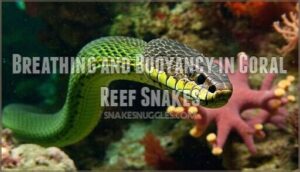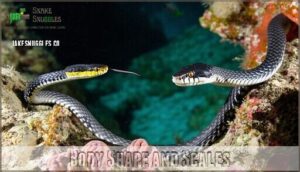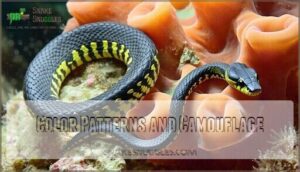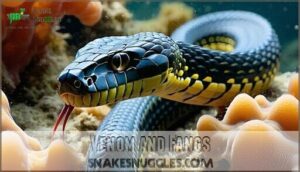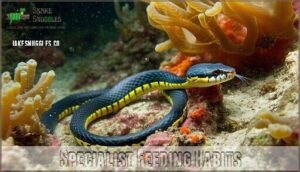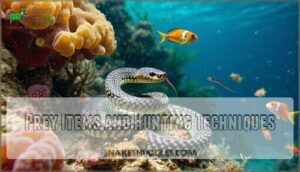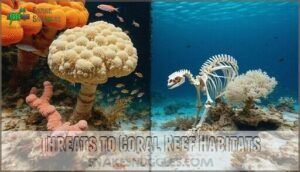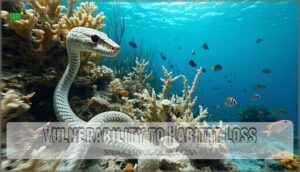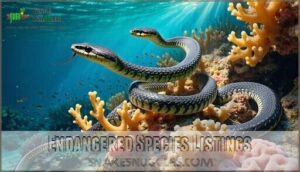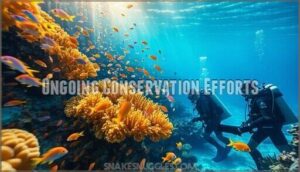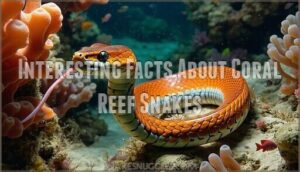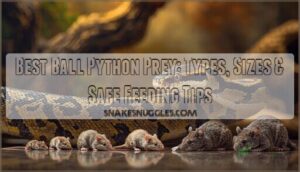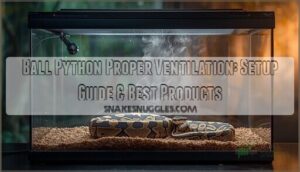This site is supported by our readers. We may earn a commission, at no cost to you, if you purchase through links.
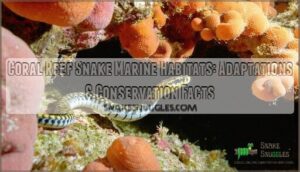 You’ll find coral reef snake marine habitats throughout the Indo-Pacific region, where these remarkable reptiles have adapted to life among vibrant coral formations.
You’ll find coral reef snake marine habitats throughout the Indo-Pacific region, where these remarkable reptiles have adapted to life among vibrant coral formations.
These sea snakes thrive in Australia’s Great Barrier Reef, Indonesia’s Raja Ampat Islands, and the Philippines’ coastal waters, preferring shallow reef environments with temperatures between 75-85°F.
Their flattened, paddle-like tails and specialized valvular nostrils allow them to navigate coral crevices while hunting fish and eels.
Most species measure 2-6 feet long and display striking banded patterns that provide perfect camouflage against coral backgrounds.
These venomous predators play essential ecosystem roles, though they’re increasingly threatened by coral bleaching and habitat degradation.
Their unique breathing adaptations reveal fascinating survival strategies.
Table Of Contents
- Key Takeaways
- Coral Reef Snake Habitats
- Breathing and Buoyancy in Coral Reef Snakes
- Characteristics of Coral Reef Snakes
- Conservation Status of Coral Reef Snakes
- Interesting Facts About Coral Reef Snakes
- Frequently Asked Questions (FAQs)
- Where do coral reef snakes live?
- What type of habitat do coral snakes live in?
- What is the habitat of the sea snakes?
- How poisonous is a coral reef snake?
- Do coral reef snakes breathe underwater?
- Are coral reef snakes amphibians?
- Do coral snakes swim in the ocean?
- What do coral reef snakes eat?
- How do coral reef snakes hunt?
- Are coral reef snakes venomous?
- Conclusion
Key Takeaways
- You’ll find coral reef snakes thriving in warm Indo-Pacific waters, particularly around Australia’s Great Barrier Reef and Indonesia’s coral formations, where they’ve adapted specialized features like paddle-shaped tails and valvular nostrils for underwater navigation.
- You’re looking at remarkable breathing adaptations that allow these marine reptiles to hold their breath for up to two hours while hunting, using sealed nostrils and extended lung capacity to survive in their aquatic environment.
- You’ll discover these snakes possess incredibly potent neurotoxic venom—up to 10 times stronger than cobra venom—which they use to quickly paralyze reef fish, eels, and crustaceans hiding in coral crevices.
- You’re witnessing a conservation crisis as coral bleaching and habitat degradation threaten these specialized predators, with nine percent of sea snake species now facing extinction and two coral reef species listed as critically endangered.
Coral Reef Snake Habitats
You’ll find these remarkable marine reptiles thriving in the warm, tropical waters of the Indo-Pacific region, where over 60 species have made coral reefs their permanent home.
Over 60 marine serpent species call Indo-Pacific coral reefs home, mastering underwater life with remarkable adaptations.
These specialized snakes have evolved incredible adaptations that allow them to navigate the complex three-dimensional world of coral formations with ease, and have made coral reefs their home.
Geographic Distribution of Coral Reef Snakes
While coral reef snakes dominate Indo-Pacific marine ecosystems, their distribution factors reveal fascinating patterns.
Over 60 species populate waters from Australia’s Great Barrier Reef to Southeast Asia, with endemic species showing remarkable habitat specificity.
Climate influence restricts their geographic distribution to warm tropical seas, creating distinct species range patterns across different reef systems.
Like their terrestrial cousins, coral snakes, some species are highly venomous members.
- You’ll find the highest coral reef snake diversity concentrated in the Coral Triangle’s pristine waters
- These serpents are completely absent from Atlantic and Caribbean reefs due to ancient climate barriers
- Australia alone harbors 30 of the world’s 70 sea snake species in its coral-rich coastal waters
Types of Coral Reefs Inhabited by Snakes
Sea snakes inhabit diverse reef types across the Indo-Pacific.
Fringing Reefs directly border coastlines, providing Hydrophiinae species with shallow hunting grounds and coral crevices.
Barrier Reefs like Australia’s Great Barrier Reef support up to fourteen species, including endemic Aipysurus laevis.
Atoll Reefs offer isolated breeding habitats, while Submerged Reefs and Artificial Reefs expand available coral reef habitats for these specialized marine serpents.
Some species, like the Dubois’ sea snake, exhibit extremely lethal venom despite being non-aggressive.
Water Depth and Temperature Preferences
You’ll find these marine snakes in shallow waters, typically 10-40 meters deep, though they can dive to 70 meters when needed.
Their thermal tolerance ranges between 24-32°C, matching coral reef conditions perfectly. Temperature preferences drive habitat selection, as feeding stops below 20°C.
Climate impacts and distribution factors limit them to warm tropical zones, avoiding cold currents that restrict their range.
Association With Hard Coral Reefs
Marine environments offer hard coral reefs as essential homes for coral reef snakes, providing everything they need to thrive.
These reef structures create perfect hunting grounds with abundant prey hiding in coral crevices. The habitat complexity supports remarkable species richness, while thermal refugia protect snakes from temperature extremes.
Hard coral reefs function as underwater cities where coral reef ecosystem dynamics sustain these remarkable marine predators.
- Reef Structure – Complex three-dimensional frameworks provide hunting ambush points
- Prey Abundance – Small fish, eels, and crustaceans concentrate in coral spaces
- Thermal Refugia – Coral formations buffer temperature fluctuations for snake comfort
- Habitat Complexity – Intricate coral architecture offers protection from larger predators
- Species Richness – Over 60 sea snake species thrive in coral reef habitats
Adaptations for Reef Life
When you explore coral reefs, you’ll discover that sea snakes have evolved remarkable adaptations for underwater life.
Their streamlined bodies and specialized scales create perfect hydrodynamics for maneuvering tight coral spaces, while their potent venom guarantees efficient hunting success in this competitive environment.
- Scale Hydrodynamics: Overlapping ventral scales reduce drag and enhance gliding through water currents
- Salt Excretion: Sublingual glands efficiently remove excess salt, enabling prolonged marine living
- Lung Capacity: Extended breath-holding abilities support deep foraging up to 100 feet underwater
Breathing and Buoyancy in Coral Reef Snakes
You’ll discover that coral reef snakes have developed remarkable respiratory adaptations that allow them to thrive in their underwater world.
These marine serpents possess specialized valvular nostrils and impressive lung capacity that enable them to hold their breath for extended periods while hunting among the coral formations.
Anatomy of Valvular Nostrils
When you examine coral reef snakes underwater, you’ll notice their valvular nostrils work like specialized gates.
These flaps create an underwater seal, preventing water entry while allowing efficient breathing at the surface.
This evolutionary advantage enables salt exclusion and maximal breathing efficiency in marine environments.
These nostrils have unique structural properties.
| Feature | Function | Benefit |
|---|---|---|
| Muscular flaps | Create watertight seal | Prevents drowning during dives |
| Flexible positioning | Opens/closes on demand | Controls airflow timing |
| Salt-resistant tissue | Blocks saline intrusion | Maintains respiratory health |
| Streamlined design | Reduces water drag | Enhances swimming efficiency |
| Neural control | Automatic closure reflex | Guarantees survival underwater |
The combination of these features allows coral reef snakes to thrive in their environment, with maximal breathing efficiency and evolutionary advantage.
This is due to the specialized gates and salt-resistant tissue that make up their nostrils, enabling them to prevent water entry and maintain respiratory health.
Ability to Hold Breath and Surface to Breathe
How do sea snakes manage their lung capacity for extended underwater forays? These remarkable reptiles possess specialized breathing adaptations that allow impressive diving duration in water environments.
- Extended breath-holding: Sea snakes can remain submerged for up to two hours using their elongated lung structure
- Cutaneous respiration: Their permeable skin assists oxygen intake during long dives underwater
- Strategic breathing frequency: They surface periodically to replenish oxygen stores efficiently
- Salt glands: Located beneath the tongue, these help maintain proper electrolyte balance during extended underwater habitat exploration
Maintaining proper humidity is essential, as improper conditions can lead to health issues.
Use of Valvular Nostrils for Breathing
You’ll find these valvular nostrils work like nature’s perfect snorkels, sealing tight underwater while opening at the surface for efficient air exchange.
This nostril function enables coral reef snakes to maximize respiration efficiency during their underwater hunting expeditions in marine snake habitats.
What makes these breathing adaptations so remarkable:
- Your heart would race watching a sea snake surface gracefully after two hours underwater
- You’d be amazed seeing how these diving adaptations prevent water from entering their lungs completely
- You’d feel relieved knowing their salt excretion system protects them from toxic seawater buildup
- You’d be impressed by how seamlessly they shift between underwater breathing and surface respiration
Paddling and Swimming Techniques
You’ll witness these marine serpents master the art of aquatic locomotion through remarkable adaptations.
Their paddle-shaped tails generate powerful tail propulsion, while synchronized body undulation creates fluid, wave-like movements.
This hydrodynamic shape minimizes water resistance, allowing them to navigate coral formations with surprising agility.
Strategic swimming patterns optimize energy conservation, enabling extended hunting sessions without exhausting their reserves, which is key to efficient tail movement through efficient tail movement.
These adaptations are key to their survival and success in their environment, showcasing their ability to thrive with remarkable adaptations.
Characteristics of Coral Reef Snakes
When you encounter coral reef snakes in their marine environments, you’ll notice their sleek, cylindrical bodies perfectly adapted for underwater life.
These remarkable serpents display vibrant color patterns that blend seamlessly with coral formations while possessing specialized features like paddle-shaped tails and venomous fangs for efficient reef hunting.
Body Shape and Scales
Coral reef snakes possess sleek bodies perfectly engineered for underwater navigation. Their lateral compression creates a torpedo-like profile that minimizes drag while swimming through coral formations.
- Scale Hydrodynamics: Overlapping scales create smooth surfaces that reduce water resistance
- Ventral scales: Specialized belly scales enhance gliding efficiency through tight coral spaces
- Streamlined design: Elongated bodies with no distinct neck optimize movement patterns
- Paddle-shaped tails: Modified tail structure provides powerful propulsion for precise maneuvering
These adaptations work together with their valvular nostrils and elongated lungs to create perfectly adapted reef predators.
Color Patterns and Camouflage
Like chameleons of the reef, coral reef snakes showcase stunning color patterns that blend seamlessly with coral environments.
Their vibrant bands of black, yellow, blue, and green create disruptive coloration for predator avoidance.
Banding significance lies in breaking up body outlines, while scale iridescence enhances color camouflage in marine habitats, making these serpents masters of disguise.
Venom and Fangs
You’ll encounter venomous elapids whose sea snake venom packs incredible punch – up to 10 times more potent than cobra venom.
These coral reef snakes possess short, fixed fangs with needle-like morphology that deliver neurotoxins causing rapid prey paralysis.
Venom evolution created fast-acting cocktails of myotoxins and cardiotoxins.
Despite extreme venom toxicity, bites remain rare, though antivenom research continues advancing treatment options.
Specialist Feeding Habits
Specializing in specific prey types, you’ll find coral reef snakes demonstrate remarkable dietary adaptations that maximize hunting efficiency.
These marine predators have evolved precise feeding strategies:
- Prey Specialization – Species like the greater sea snake exclusively target striped eel catfish
- Venom Potency – Neurotoxins perfectly calibrated for their chosen reef fish prey
- Ontogenetic Shifts – Juveniles start with crustaceans before switching to adult diets of eels
Coral reef snakes, like other snakes, require appropriate temperature for digestion to properly process their meals.
Prey Items and Hunting Techniques
You’ll find coral reef snakes targeting small reef fish, eels, and soft-bodied crustaceans using ambush predation tactics.
Their venom potency guarantees quick prey immobilization. Juvenile diet consists mainly of larval fish and tiny crustaceans.
These hunting strategies shift seasonally—wet seasons favor schooling fish, while dry periods focus on bottom-dwelling prey through strategic positioning.
A related species has a specific dietary need that is also worth noting for a deeper understanding of coral reef snakes.
Conservation Status of Coral Reef Snakes
You’ll find that coral reef snakes face mounting conservation challenges as their vibrant underwater homes experience unprecedented threats from human activities and climate change.
These specialized marine reptiles depend entirely on healthy coral ecosystems, making them particularly vulnerable when reef habitats deteriorate or disappear altogether, which poses significant threats to their survival due to their dependence on these delicate environments.
Threats to Coral Reef Habitats
Most coral reef habitats face mounting threats that endanger the snakes depending on them.
Ocean acidification weakens coral structures, while plastic pollution clogs feeding areas.
Overfishing impacts disrupt food webs, and coastal development destroys breeding grounds.
- Coral bleaching events strip reefs of color and life
- Tourism effects damage fragile coral formations through boat anchors
- Agricultural runoff triggers harmful algal blooms
- Blast fishing destroys entire reef sections instantly
- Rising sea temperatures stress coral reef ecosystems beyond recovery
The combination of these threats, including ocean acidification, highlights the urgent need for conservation efforts to protect these delicate ecosystems.
Effects of Climate Change on Snakes
Rising temperatures turn coral reef ecosystems into challenging marine habitats for coral reef snakes.
Climate change triggers bleaching impacts that destroy essential shelters, while ocean acidification weakens coral structures.
These habitat shifts force snakes into unfamiliar territories, disrupting hunting patterns.
Prey availability fluctuates as fish populations relocate, creating food shortages that threaten snake survival and marine conservation efforts.
Vulnerability to Habitat Loss
Coral reef snakes increasingly face devastating habitat loss as human activities and environmental changes threaten their underwater homes.
These marine reptiles depend entirely on healthy coral reef ecosystems, making them extremely vulnerable when their habitats deteriorate.
The following threats create cascading effects throughout the coral reef ecosystem:
- Bleaching impact strips away colorful coral homes, leaving barren underwater deserts
- Pollution effects poison both snakes and their prey through toxic runoff and plastic waste
- Fishing threats remove essential food sources while nets entangle unsuspecting marine reptiles
- Coastal development destroys critical breeding and nursery areas through dredging and construction
Tourism impact compounds these problems as increased boat traffic and diving activities disturb fragile reef structures.
Without immediate coral reef conservation efforts, these specialized marine reptiles face an uncertain future in rapidly changing oceans.
Endangered Species Listings
International conservation bodies have classified nine percent of sea snake species as threatened with extinction.
You’ll find two coral reef species—Aipysurus apraefrontalis and Aipysurus foliosquama—listed as Critically Endangered, with population decline exceeding ninety percent.
The Dusky Sea Snake carries endangered status under multiple conservation actions, while recovery plans target habitat protection through marine reserves and coral reef conservation initiatives.
Ongoing Conservation Efforts
Looking beyond species protection, active conservation efforts focus on habitat preservation and community involvement.
Organizations worldwide implement thorough strategies to safeguard coral reef snake populations:
- Reef Restoration programs rebuild damaged coral structures through coral gardening and transplantation techniques.
- Marine Protected Areas establish fishing regulations and restrict harmful activities in critical snake habitats.
- Pollution Reduction initiatives target agricultural runoff and plastic waste affecting reef ecosystems.
- Community Engagement programs train local fishermen in sustainable tourism practices and conservation awareness.
Interesting Facts About Coral Reef Snakes
You’ll discover that coral reef snakes possess some of the most remarkable adaptations in the marine world, from their ability to taste-test water with their tongues to their impressive two-hour breath-holding records.
These fascinating serpents have evolved extraordinary strategies for survival that make them perfectly suited for life among the corals, revealing surprising behaviors and ecological relationships that continue to amaze marine biologists, showcasing their ability to thrive in a unique environment with impressive adaptability.
Unique Adaptations for Reef Life
You’ll find these snakes are living masterpieces of venom evolution and behavioral adaptations.
Their paddleshaped tails and valvular nostrils work like built-in snorkels, while specialized salt excretion glands handle seawater.
Scale hydrodynamics create streamlined bodies, and impressive lung capacity supports extended dives.
Camouflage strategies blend seamlessly with coral patterns, making these snake adaptations perfectly suited for reef hunting.
Reproductive Strategies
Unlike most reptiles, sea snakes showcase fascinating viviparous reproduction, giving birth to live young rather than laying eggs.
You’ll find these marine serpents engaging in elaborate mating rituals during their breeding season, with females storing sperm for months before the gestation period begins.
- Viviparous reproduction means babies develop inside mom, no eggs involved
- Sperm storage allows females to delay pregnancy until conditions are perfect
- Gestation periods last 6-7 months in warm reef waters
- Litter sizes stay small (2-10 babies) but young are born ready to hunt
- Breeding seasons align with ideal water temperatures for newborn survival
Interesting Behaviors and Observations
How do coral reef snakes surprise researchers with their complex behaviors?
These marine serpents display fascinating nocturnal hunting patterns and intriguing behaviors that reveal their sophisticated nature.
| Behavior Category | Observable Action | Scientific Significance |
|---|---|---|
| Hunting Strategies | Ambush predators using coral crevices | Energy-efficient prey capture |
| Social Gatherings | Seasonal congregations for mating | Reproductive success optimization |
| Sensory Perception | Chemical detection through tongue-flicking | Enhanced predatory behaviors navigation |
Venom usage varies dramatically between species, while cleaning behavior involves rubbing against coral surfaces to remove parasites.
Their tail movements deter potential predators.
These snake behavior adaptations showcase remarkable reef specialization.
Importance of Coral Reef Snakes in The Ecosystem
You’ll find that coral reef snakes serve as vital indicator species, signaling ecosystem health through their presence.
These predators maintain coral reef ecosystem balance by regulating prey populations, preventing trophic cascade effects that could destabilize marine habitats.
Their specialized hunting controls fish numbers, supporting reef biodiversity and demonstrating their pivotal role in ecosystem stability within coral reef ecosystems.
Frequently Asked Questions (FAQs)
Where do coral reef snakes live?
You’ll find these venomous snakes thriving in warm Indo-Pacific waters, particularly around Australia’s Great Barrier Reef, Indonesia’s coral-rich seas, and the Philippines’ tropical reefs where temperatures stay between 77-86°F.
What type of habitat do coral snakes live in?
Sea snakes thrive in warm tropical coral reefs of the Indo-Pacific, where you’ll find them hunting among colorful corals and rock crevices at depths under 50 feet.
What is the habitat of the sea snakes?
You’ll spot sea snakes gliding through warm, shallow waters, especially near coral reefs, mangroves, and estuaries in the Indo-Pacific region.
They prefer protected coves, thriving where reef fish are plentiful and crevices offer shelter.
How poisonous is a coral reef snake?
Don’t bite off more than you can chew when encountering these marine predators.
You’ll face potentially deadly neurotoxic venom that paralyzes prey within seconds, though human bites remain rare and require immediate antivenom treatment.
Do coral reef snakes breathe underwater?
You’ll breathe air, not water – coral reef snakes surface every hour or two using specialized valvular nostrils that seal shut during dives, preventing drowning while they hunt underwater.
Are coral reef snakes amphibians?
No, you can’t classify coral reef snakes as amphibians—they’re reptiles.
While they’re perfectly adapted for aquatic life, they lack amphibians‘ key traits like permeable skin for breathing and metamorphosis from larvae to adults.
Do coral snakes swim in the ocean?
Yes, coral snakes do swim in the ocean.
They’ll find them gliding through warm, shallow waters, using their paddle-shaped tails and streamlined bodies to navigate coral reefs, hunt prey, and avoid predators with impressive agility.
What do coral reef snakes eat?
You’ll find these marine predators hunt small reef fish, eels, and crustaceans hiding in coral crevices. They use potent neurotoxic venom to paralyze prey within seconds during nighttime ambushes.
How do coral reef snakes hunt?
You’ll spot these stealthy hunters using ambush tactics, hiding in coral crevices and striking lightning-fast when unsuspecting reef fish swim by, paralyzing prey instantly with potent neurotoxic venom.
Are coral reef snakes venomous?
Coral reef snakes pack potent neurotoxic venom that’ll paralyze prey in seconds.
You’re looking at some seriously effective hunters here – their venom contains powerful toxins that shut down nervous systems instantly, making them incredibly efficient predators in reef environments, with neurotoxic venom.
Conclusion
Thriving coral reefs once teemed with diverse marine life, yet today’s bleached skeletal remains tell a different story for coral reef snake marine habitats.
You’ve discovered how these remarkable reptiles evolved specialized adaptations like valvular nostrils and paddle-shaped tails to navigate complex reef ecosystems.
Their survival depends entirely on healthy coral formations that provide hunting grounds and shelter.
As ocean temperatures rise and reefs continue degrading, you’re witnessing a critical moment where conservation efforts will determine whether these unique sea snakes maintain their essential ecological roles in Indo-Pacific waters.
- https://www.sciencedirect.com/science/article/pii/S2949790624000016
- https://www.britannica.com/place/Timor-Sea
- https://core.ac.uk/download/pdf/269293191.pdf
- https://www.aims.gov.au/research-topics/marine-life/sea-snakes
- https://theconversation.com/there-are-dozens-of-sea-snake-species-in-the-indian-and-pacific-oceans-but-none-in-the-atlantic-or-caribbean-why-91452

